捏脊治疗小儿厌食症60例
- 格式:pdf
- 大小:69.80 KB
- 文档页数:1
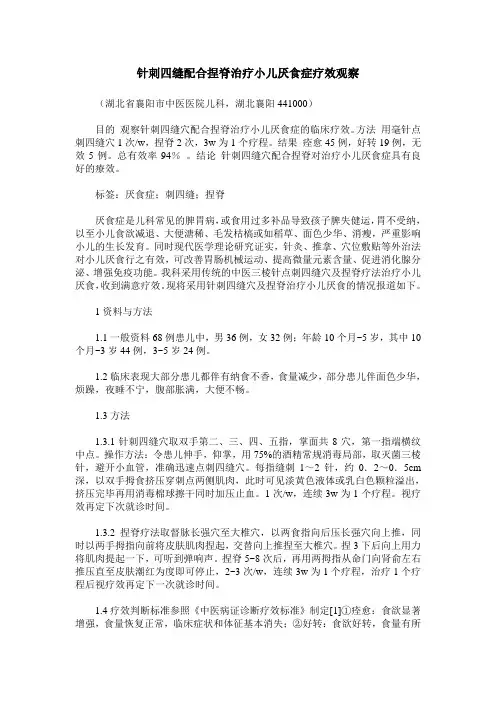
针刺四缝配合捏脊治疗小儿厌食症疗效观察(湖北省襄阳市中医医院儿科,湖北襄阳441000)目的观察针刺四缝穴配合捏脊治疗小儿厌食症的临床疗效。
方法用毫针点刺四缝穴1次/w,捏脊2次,3w为1个疗程。
结果痊愈45例,好转19例,无效5例。
总有效率94%。
结论针刺四缝穴配合捏脊对治疗小儿厌食症具有良好的療效。
标签:厌食症;刺四缝;捏脊厌食症是儿科常见的脾胃病,或食用过多补品导致孩子脾失健运,胃不受纳,以至小儿食欲减退、大便溏稀、毛发枯槁或如稻草、面色少华、消瘦,严重影响小儿的生长发育。
同时现代医学理论研究证实,针灸、推拿、穴位敷贴等外治法对小儿厌食行之有效,可改善胃肠机械运动、提高微量元素含量、促进消化腺分泌、增强免疫功能。
我科采用传统的中医三棱针点刺四缝穴及捏脊疗法治疗小儿厌食,收到满意疗效。
现将采用针刺四缝穴及捏脊治疗小儿厌食的情况报道如下。
1资料与方法1.1一般资料68例患儿中,男36例,女32例;年龄10个月~5岁,其中10个月~3岁44例,3~5岁24例。
1.2临床表现大部分患儿都伴有纳食不香,食量减少,部分患儿伴面色少华,烦躁,夜睡不宁,腹部胀满,大便不畅。
1.3方法1.3.1针刺四缝穴取双手第二、三、四、五指,掌面共8穴,第一指端横纹中点。
操作方法:令患儿伸手,仰掌,用75%的酒精常规消毒局部,取灭菌三棱针,避开小血管,准确迅速点刺四缝穴。
每指缝刺1~2针,约0.2~0.5cm 深,以双手拇食挤压穿刺点两侧肌肉,此时可见淡黄色液体或乳白色颗粒溢出,挤压完毕再用消毒棉球擦干同时加压止血。
1次/w,连续3w为1个疗程。
视疗效再定下次就诊时间。
1.3.2捏脊疗法取督脉长强穴至大椎穴,以两食指向后压长强穴向上推,同时以两手拇指向前将皮肤肌肉捏起,交替向上推捏至大椎穴。
捏3下后向上用力将肌肉提起一下,可听到弹响声。
捏脊5~8次后,再用两拇指从命门向肾俞左右推压直至皮肤潮红为度即可停止,2~3次/w,连续3w为1个疗程,治疗1个疗程后视疗效再定下一次就诊时间。
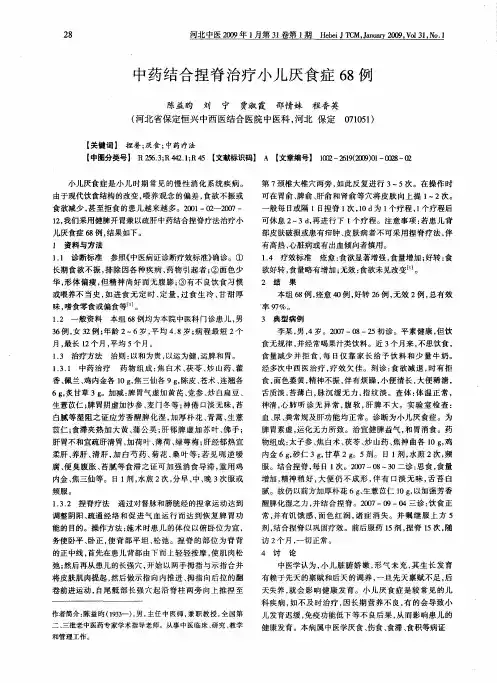
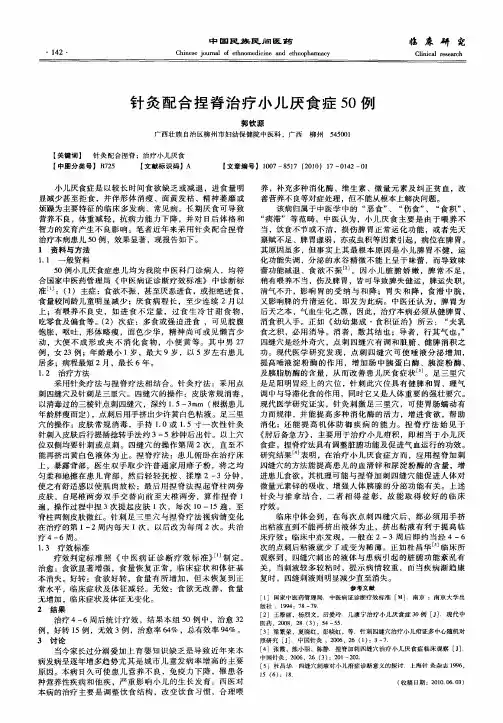
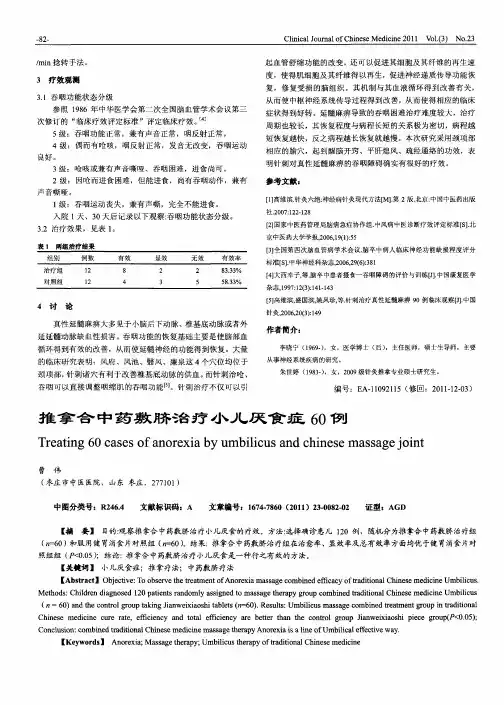
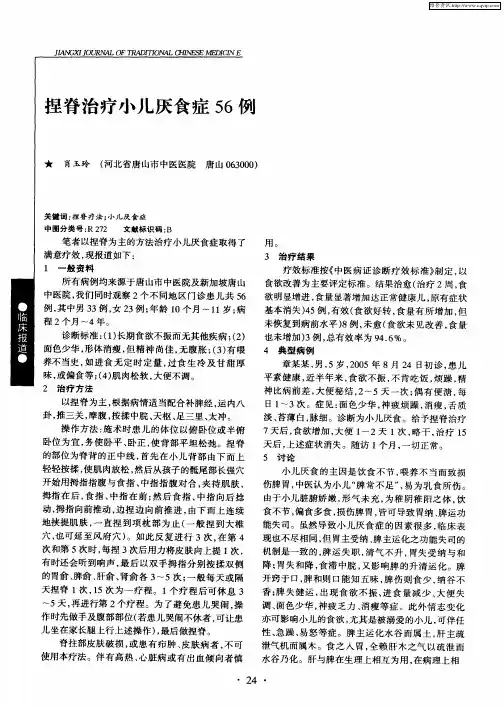
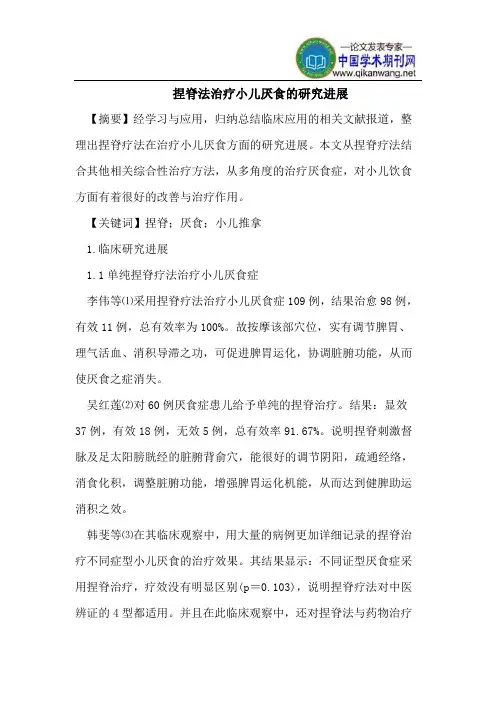
捏脊法治疗小儿厌食的研究进展【摘要】经学习与应用,归纳总结临床应用的相关文献报道,整理出捏脊疗法在治疗小儿厌食方面的研究进展。
本文从捏脊疗法结合其他相关综合性治疗方法,从多角度的治疗厌食症,对小儿饮食方面有着很好的改善与治疗作用。
【关键词】捏脊;厌食;小儿推拿1.临床研究进展1.1单纯捏脊疗法治疗小儿厌食症李伟等⑴采用捏脊疗法治疗小儿厌食症109例,结果治愈98例,有效11例,总有效率为100%。
故按摩该部穴位,实有调节脾胃、理气活血、消积导滞之功,可促进脾胃运化,协调脏腑功能,从而使厌食之症消失。
吴红莲⑵对60例厌食症患儿给予单纯的捏脊治疗。
结果:显效37例,有效18例,无效5例,总有效率91.67%。
说明捏脊刺激督脉及足太阳膀胱经的脏腑背俞穴,能很好的调节阴阳,疏通经络,消食化积,调整脏腑功能,增强脾胃运化机能,从而达到健脾助运消积之效。
韩斐等⑶在其临床观察中,用大量的病例更加详细记录的捏脊治疗不同症型小儿厌食的治疗效果。
其结果显示:不同证型厌食症采用捏脊治疗,疗效没有明显区别(p=0.103),说明捏脊疗法对中医辨证的4型都适用。
并且在此临床观察中,还对捏脊法与药物治疗法对脾胃气虚证小儿厌食治疗效果进行了比较,结果显示捏脊组疗效优于对照组。
说明辨证为脾胃气虚证的厌食症患儿选用捏脊疗法比口服药物疗效更好。
1.2 捏脊疗法配以相关穴位治疗小儿厌食症岑万玲等⑷认为揉板门、推四横纹、揉中脘及摩腹能健脾和胃、理气消食。
揉足三里,能健脾和胃,调中理气,导滞通络,清补脾,健脾助运,清胃开胃,纳消食积。
捏脊能调理阴阳、理气血、和脏腑、通经络、培元气、对调整五脏六腑功能及推动气血的正常运行有积极作用。
笔者采用顺逆结合摩腹法意在理气消积,调和胃。
通过上述的治疗在55例病例中,总有效率为94.5%。
崔壹⑸通过对140例小儿厌食症患者进行捏脊加按压足三里、内关、肾俞、胃俞、脾俞、天枢气海等穴位治疗的观察,总有效率为92.46%。
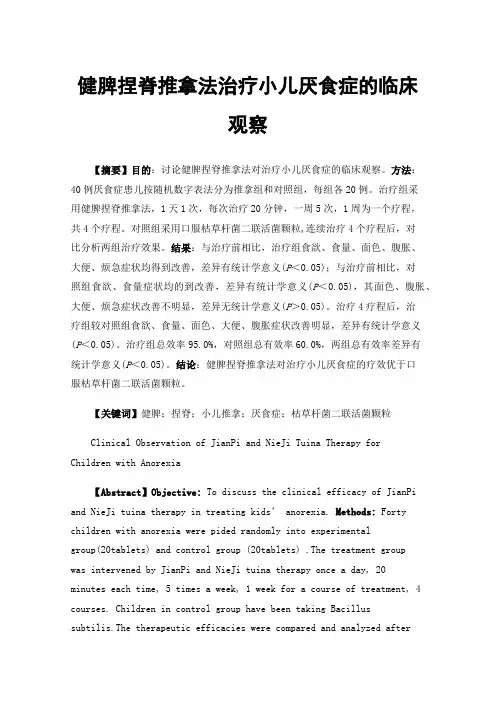
健脾捏脊推拿法治疗小儿厌食症的临床观察【摘要】目的:讨论健脾捏脊推拿法对治疗小儿厌食症的临床观察。
方法:40例厌食症患儿按随机数字表法分为推拿组和对照组,每组各20例。
治疗组采用健脾捏脊推拿法,1天1次,每次治疗20分钟,一周5次,1周为一个疗程,共4个疗程。
对照组采用口服枯草杆菌二联活菌颗粒,连续治疗4个疗程后,对比分析两组治疗效果。
结果:与治疗前相比,治疗组食欲、食量、面色、腹胀、大便、烦急症状均得到改善,差异有统计学意义(P<0.05);与治疗前相比,对照组食欲、食量症状均的到改善,差异有统计学意义(P<0.05),其面色、腹胀、大便、烦急症状改善不明显,差异无统计学意义(P>0.05)。
治疗4疗程后,治疗组较对照组食欲、食量、面色、大便、腹胀症状改善明显,差异有统计学意义(P<0.05)。
治疗组总效率95.0%,对照组总有效率60.0%,两组总有效率差异有统计学意义(P<0.05)。
结论:健脾捏脊推拿法对治疗小儿厌食症的疗效优于口服枯草杆菌二联活菌颗粒。
【关键词】健脾;捏脊;小儿推拿;厌食症;枯草杆菌二联活菌颗粒Clinical Observation of JianPi and NieJi Tuina Therapy forChildren with Anorexia【Abstract】Objective: To discuss the clinical efficacy of JianPi and NieJi tuina therapy in treating kids’ anorexia. Methods: Forty children with anorexia were pided randomly into experimentalgroup(20tablets) and control group (20tablets) .The treatment groupwas intervened by JianPi and NieJi tuina therapy once a day, 20minutes each time, 5 times a week, 1 week for a course of treatment, 4 courses. Children in control group have been taking Bacillussubtilis.The therapeutic efficacies were compared and analyzed aftertreatment for 4 successive courses. Results: Compared with no cure before, the treatment group´s symptoms such as appetite, Capacity for eating, complexion, ventosity, dejecta and sentiment wereimproved ,and the difference was of statistical significance (P<0.05); while the control group´s symptoms such as the appetite, Capacity for eating were improved , and the difference was of statistical significance (P<0.05),but symptoms like complexion, ventosity, dejecta and sentiment were of no significant improvement. and the difference was not of statistical significance(P>0.05).After 4 courses treatment, the massage group’s curative effect for diseases like the appetite, Capacity for eating, complexion,ventosity and dejecta is much better than that of the control group (P<0.05). The total effective rate of treatment group was 95.0% ,while the effective rate of control group was 60.0% .The difference between two groups was statistically significant (P<0.05).Conclusion: JianPi and NieJituina therapy can have a better therapeutic efficacy in treating children with anorexia compared to oral administration of Bacillus subtilis.【Keywords】:Tonifying Spleen;ChiropacticThreapy; PediatricTuina;anorexia; Bacillus subtilis.Anorexia in children is characterized by long-term loss of appetite, reduced food intake, lack of greed for food, and even feel disgusting for it, but the spirit is still good. Anorexia is also accompanied by facelessness, thin and short body of children, and itis one of the most common diseases in childhood. Studies have shownthat the morbidity of anorexia in children in China is about 12% to34%[1] ,and the incidence rate is still rising in recent years. Long-term anorexia leads to growth retardation,short stature, low immunity, malnutrition, anemia and other diseases, and such symptoms also have been seen much frequently than that of normal children of the same age.Therefore, in order to find an effective way to treat the anorexia in children,we observed the clinical efficacy of JianPi and NieJituina therapy for children with anorexia, and compared it with oral Bacillus subtilis. Now, the report is shown as follows:1.Clinical Material1.1 General dataForty Infantile Anorexia who were in line with the inclusion criteria were selected and pided into the treatment group and the control group by the random number table method, 20 cases in each group. There was no distinct difference between the two groups in the baseline of gender, age and disease duration , which wascomparable.For much details please see Table1.Table 1.Baseline comparison between the two groupsGroup CasesGender Age(years)Course(months)malefemaletreat ment2113.31±1.283.24±1.21contr291 3.33± 3.37±1ol01 1.27.341.2 Diagnostic criteriaThe diagnostic criteria were based on the Criteria of Thirteenth Five-Year Plan Pediatrics of Traditional Chinese Medicine edited by Ma Rong[2]:major symptoms include Long-term no appetite, less food intake, obvious weight loss, a lusterless complexion and a low body height, and may have belching, dysentery, convulsions; stool irregularities, but the spirit is acceptable. Age is limited to 1 to 6 years old, The anorexia lasted for at least 2 months. Simultaneously, Anorexia which caused by other diseases are excluded.1.3 Exclusion criteriaTuina contraindications,such as skin damage,infection, eczema;and complicated with severe primary diseases such as cardiovascular, liver,kidney and hematopoietic system dysfunction and mentalillness;children who are unable to complete the entire treatment process,have poor compliance or are participating other clinical trials.2 Treatment Methods2.1 TreatmentgroupAdopting Jian Pi and NieJi tuina therapy and the specific operation steps are as follows:①The child takes the supine position or sit on parent’s lap, supplement Feijing 300times,supplement pi jing300 times, tonify Shenjing 300 times, clear Ganjing 100 times, clear Xinjing 100 times,Rou- knead banmen100times, Rou-knead nei ba gua 100 times, Rou-knead zusanli(ST36),Pinch sifeng;and zhongwan(RN12)100 times;②The child takes aprone position, the doctors rub Infantile back with palm 5 times. Rou-knead and Ca-rub Feishu (BL 13), Pishu (BL 20), and Shenshu (BL 23)respectively for 30 seconds, Nie-pinch spine for 4times and Na-grasp Jianjing (GB 21) for3-5times, Rou-knead guiwei 50 times, Tui-push shangqijiegu100 times, Rubbing lumbosacral sectionwith heat.③The child takes the supine position, rubbing abdomen3minutes, shocking abdomen 1minutes,Na-Rou abdomen 50 times, Hit back10 times. Treatment duration: The massage medium uses talcum powder, once a day, 20 minutes each time, 5 times a week, 1 week for a course, totally4 courses.2.2 Control groupTreated with Mommy Love (Bacillus subtilis granules) (Beijing Han mei Pharmaceutical Co., Ltd., Sinopharm S2*******), orally, 1 bag/time, 2 times/day. 5 days for a course and totally 4 courses.3 Therapeutic Observation3.1 Observation itemsPediatric anorexia symptom grading standard, Reference《Guidelines for Clinical Research of New Drugs in Traditional Chinese Medicine》[3]The symptoms and signs were scored by 4 levels, and the scoringcriteria are shown in Table 2.Table 2. Criteria for scoring symptoms and signsItem0point(Normal)1point(Slight)2points(Moderate)3points(Sev)orexia Normal1/4 less thannormal1/3 less thannormal1/2 less thnormalCapacit y for eating Normal Hunger ,eating lessReluctant toeatNoappetite,can'tcomplex ion Normal Dull Lack lustre,lip palePale and drlipventosityNormal Slightly Obvious Unbearabledejecta Normal Thin or dry thin and 1-2times a day or 2times a day, hardthinner,2ti a day or more than2days, hardsentime nt Normal Occasionalcrying,IrritabilityOften cryingfor no reasonRestlessnesyingrepeatedly,can'fall sleep3.2 Criteria of clinical efficacyThe clinical efficacy was evaluated based on the improvement rate of the total score of symptoms and signs. Improvement rate of totalscore = (Pre- treatment total score - Post-treatment total score) ÷ Pre-treatment total score × 100%.Clinical recovery: total score improvement rate ≥ 95%;Markedly effective: total score improvement rate≥ 70%, < 95%Effective: total score improvement rate≥ 30%, <70%Invalid: total score improvement rate< 30%.3.3 Statistical analysisThe SPSS 21.0 version software was applied to analyze data ,Chi-square test was adopted for counting data. Measurement data in normal distribution with homogeneity of variance were expressed asmean±standard deviation (), and analyzed by t-test.There is a statistically significant difference when P<0.05.3.4Results3.4.1Comparative analysis of symptomsCompared with no any treatment before, the treatmentgroup´symptoms such as the appetite, capacity for eating, complexion, ventosity, dejecta and sentiment were improved ,and the difference was of statistical significance (P<0.05). Compared with no medical treatment, the control group´symptoms such as the appetite, Capacity for eating were improved , and the difference was of statistical significance (P<0.05),complexion, ventosity, dejecta and sentiment were not improved obviously, and the difference was not statistically significant (P>0.05). After treatment for 4 courses, the symptoms such as the appetite, capacity for eating, complexion, ventosity anddejecta were significantly improved in the massage group compared with the control group (P<0.05).Group n Time orexia Capacity foreatingcomplexionventositytreat ment2Pre-treatment4.50±1.435.10±1.213.90±1.203.30±1.631Post-treatment1.10±1.211)3)1.10±1.521)3)1.30±1.871)3)0.45±0.831)3).contr ol2Pre-treatment4.90±1.374.90±1.373.50±1.823.10±1.524Post-treatment3.45±1.231)3.50±1.431)2.90±1.372)2.80±1.642).Table parison of the symptoms scores of children with anorexiabefore and after treatment()Note: Intra-group comparison, 1) P<0.05; Intra-group comparison, 2 )P>0.05;compared with the control group after treatment,3) P<0.05;compared with the control group after treatment,4) P>0.05.3.4.2clinical efficaciesThe total effective rate of treatment group was 95.0% ,while the effective percentage of control group was 60.0%,and the difference was of statistical significance (P<0.05).Table 4.The clinical efficacy between the two groupsGroup n CureSignificant effecteffectiveinvalidTotalefficiencytreat ment22(10%)14(70%)3(15%)1(5%)19(95%)contr ol202(10%)10(50%)8(40%)12(60%)DiscussionChildren, for their special body structure, often have unsound function of spleen. The main reasons for anorexia are diet incontinence, always eating junk food and not eating on time, which develop partial eclipse or eating irregularities. In recent years, the incidence rate of anorexia in children has become higher and higher. Therefore, it is particularly important to seek safe and effective treatment.The results of this study show that: JianPi and NieJi tuina therapy has a good effect on improving the appetite, capacity for eating, complexion, ventosity, dejecta of children with anorexia. The total effective rate of the treatment group was 95%, and the controlgroup´s was 60%.. The effective percentage of the experimental group was superior to the control group, which indicate that JianPi and NieJi tuina therapy is superior to the oral taking Bacillus subtilis.Infantile WuJing points, SiFeng points, BanMen points, NeiBaGua points have the effect of eliminating food accumulation and helping build the fuction of pi.《LiZheng massage》:Using the palm of your hand and rubbing abdomen cure over-sickness;zusanli(ST36) belongs to urinary bladder channel of foot tiayang(UB)which can help spleen and stomach be strong, improve the digestive function of children. NieJi is mainlyused to stimulate the Du Meridian and UB, and the Du Meridian is the yang of the Governor of the Sea of the Yangmai. UB is the place where the Wuzang LiuFu points are located, which is closely related to the viscera. NieJi tuina therapy regulates the body's qi and blood and the effects of organs. JianPi and NieJi tuina therapy can weaken the symptoms of anorexia in children and the possible reason for that may be related to the ability of massage which are good to promote the secretion of appetite factors such as Ghrelin, NPY and enhance gastrointestinal motility. The Research shows[4],The treatment of anorexia in children with abdomen chiropractic has significantclinical efficacy, which can effectively enhance the gastric motility of children, shorten the time required for gastric emptying, and improve the intestinal mucosal absorption function of children. The massage is a method of stimulating the acupoints of body surface by hand which can achieve the effect similar to the acupuncture and moxibustion treatment. Fu's [5] study showed that acupuncture at SiFeng can effectively promote the secretion of ghrelin and NPY, inhibit the production of Leptin, and improve the appetite of children. Studies have reported that the mechanism of chiropractic regulation of gastrointestinal function may change the concentration ofneuropeptides such as Ghrelin and VIP[6].Therefore, we speculate that it is possible to promote the secretion of ghrelin and NPY by massage, so as to improve the anorexia symptoms of children, but how to promotethe secretion of appetite factors, that is the mechanism which remains a further study.Reference:[1] Zhuang Haiyan.The etiology, pathogenesis and treatment of anorexia in children [J]. Clinical Research in Traditional Chinese Medicine, 2016, 8 ( 17): 14.[2] Ma Rong.Traditional Chinese Medicine Pediatrics.10th Edition[M] Beijing: China Traditional Chinese Medicine Press, 2016.[3] Zheng Yu. Guiding Principles for Clinical Research of NewDrugs in China (Trial) [M]Beijing: China Medical Science Press, 2002: 269.SUN Bo.Curative Effect of Rubbing Abdomen and Spinal Pinching on Children with Spleen Qi Deficiency Type of Anorexia and The Influenceon Intestinal Mucosa Absorption Function [J]Chinese Archives of tradmonal Chinese Medicine .2018:36(8):1901-1903.Fu Mei Yuan.Impacts on the Appetite Regulating Factors ofInfantile an Orexia Treated with Acupuncture at Si Feng.Chinese Acupuncture and Moxibustion 2013.33(2):117-120.LI Xue chao.Influence of Chiropractic Therapy on Contents ofGhrelin and Vasoactive Intestinal Peptide in Rabbit with Bradygastria. [J]Chinese Journal of Traditional Chinese Medicine andPharmacy.2016.31(2):637-639.1Author:Huang Xue-ping,Resident doctor,master.2Corresponding Author:Huang Kai-yun,Chief physician,email:*****************.。
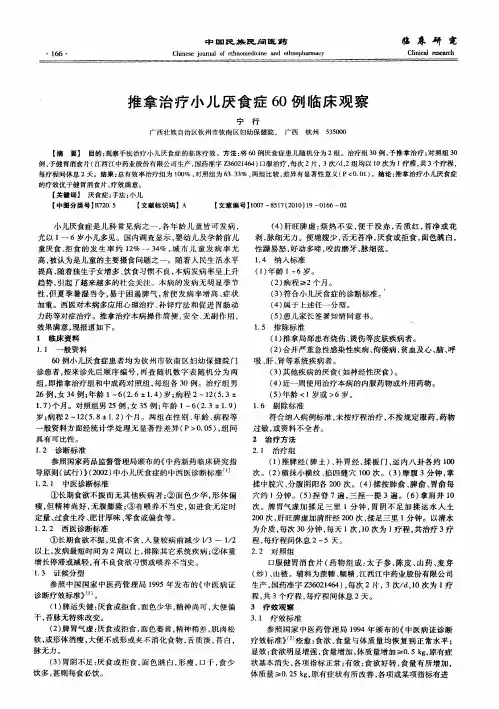
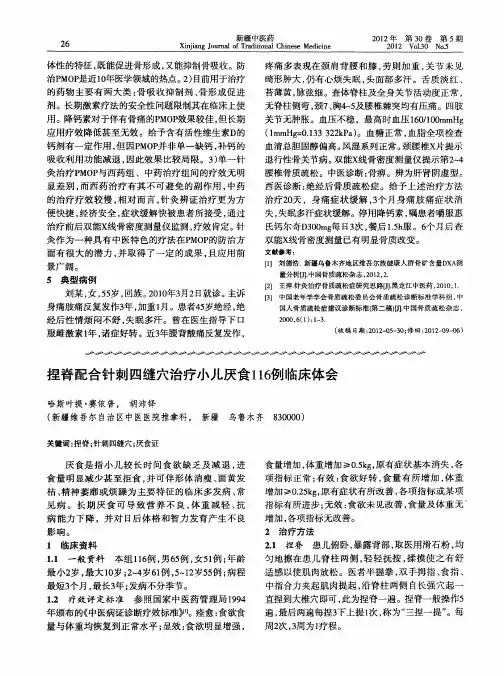
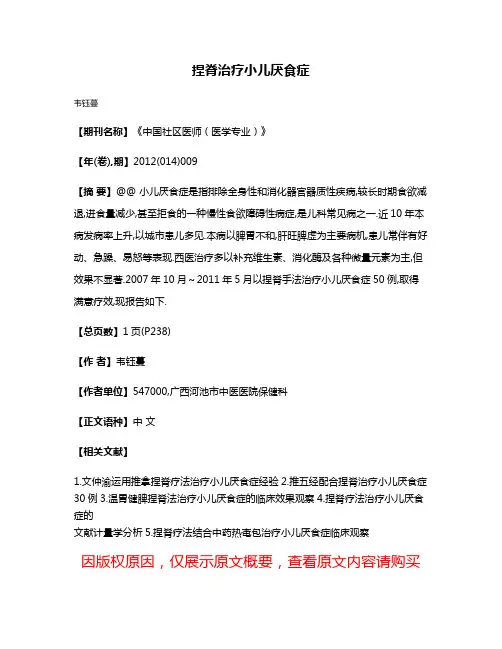
捏脊治疗小儿厌食症
韦钰蔓
【期刊名称】《中国社区医师(医学专业)》
【年(卷),期】2012(014)009
【摘要】@@ 小儿厌食症是指排除全身性和消化器官器质性疾病,较长时期食欲减退,进食量减少,甚至拒食的一种慢性食欲障碍性病症,是儿科常见病之一.近10年本病发病率上升,以城市患儿多见.本病以脾胃不和,肝旺脾虚为主要病机,患儿常伴有好动、急躁、易怒等表现.西医治疗多以补充维生素、消化酶及各种微量元素为主,但效果不显著.2007年10月~2011年5月以捏脊手法治疗小儿厌食症50例,取得满意疗效,现报告如下.
【总页数】1页(P238)
【作者】韦钰蔓
【作者单位】547000,广西河池市中医医院保健科
【正文语种】中文
【相关文献】
1.文仲渝运用推拿捏脊疗法治疗小儿厌食症经验
2.推五经配合捏脊治疗小儿厌食症30例
3.温胃健脾捏脊法治疗小儿厌食症的临床效果观察
4.捏脊疗法治疗小儿厌食症的
文献计量学分析5.捏脊疗法结合中药热奄包治疗小儿厌食症临床观察
因版权原因,仅展示原文概要,查看原文内容请购买。
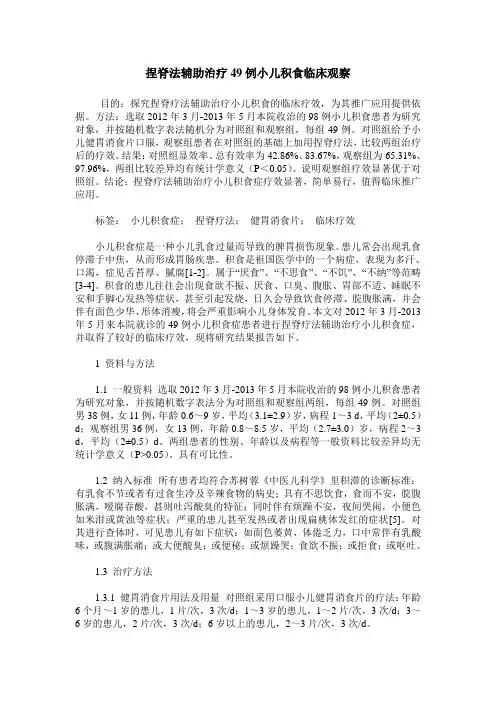
捏脊法辅助治疗49例小儿积食临床观察目的:探究捏脊疗法辅助治疗小儿积食的临床疗效,为其推广应用提供依据。
方法:选取2012年3月-2013年5月本院收治的98例小儿积食患者为研究对象,并按随机数字表法随机分为对照组和观察组,每组49例。
对照组给予小儿健胃消食片口服,观察组患者在对照组的基础上加用捏脊疗法,比较两组治疗后的疗效。
结果:对照组显效率、总有效率为42.86%、83.67%,观察组为65.31%、97.96%,两组比较差异均有统计学意义(P<0.05)。
说明观察组疗效显著优于对照组。
结论:捏脊疗法辅助治疗小儿积食症疗效显著,简单易行,值得临床推广应用。
标签:小儿积食症;捏脊疗法;健胃消食片;临床疗效小儿积食症是一种小儿乳食过量而导致的脾胃损伤现象。
患儿常会出现乳食停滞于中焦,从而形成胃肠疾患。
积食是祖国医学中的一个病症,表现为多汗、口渴,症见舌苔厚、腻腐[1-2]。
属于“厌食”、“不思食”、“不饥”、“不纳”等范畴[3-4]。
积食的患儿往往会出现食欲不振、厌食、口臭、腹胀、胃部不适、睡眠不安和手脚心发热等症状,甚至引起发烧,日久会导致饮食停滞、脘腹胀满,并会伴有面色少华、形体消瘦,将会严重影响小儿身体发育。
本文对2012年3月-2013年5月来本院就诊的49例小儿积食症患者进行捏脊疗法辅助治疗小儿积食症,并取得了较好的临床疗效,现将研究结果报告如下。
1 资料与方法1.1 一般资料选取2012年3月-2013年5月本院收治的98例小儿积食患者为研究对象,并按随机数字表法分为对照组和观察组两组,每组49例。
对照组男38例,女11例,年龄0.6~9岁,平均(3.1±2.9)岁,病程1~3 d,平均(2±0.5)d;观察组男36例,女13例,年龄0.8~8.5岁,平均(2.7±3.0)岁,病程2~3 d,平均(2±0.5)d。
两组患者的性别、年龄以及病程等一般资料比较差异均无统计学意义(P>0.05)。
观察捏脊、推拿中医干预对严重功能性消化不良伴厌食症患儿的治疗效果发表时间:2018-04-04T13:45:34.307Z 来源:《中国蒙医药》2018年第1期作者:肖常锋李艳红余奇[导读] 对严重功能性消化不良伴厌食症患儿应用捏脊、推拿中医干预的效果观察。
湖南省娄底市康复医院湖南娄底 417000【摘要】目的:对严重功能性消化不良伴厌食症患儿应用捏脊、推拿中医干预的效果观察。
方法:随机抽取2016年8月-2017年8月本院儿科接收并施予单纯西药治疗的50例严重功能性消化不良伴厌食症患儿作为A组,另选同期接收并施予中医捏脊与推拿治疗的50例同疾病患儿作为B组,对比两组的治疗情况。
结果:B组患儿的中医证候积分均低于A组,对比有统计学意义(P<0.05);且A组临床治疗有效率是76.0%,低于B的94.0%,差异具备统计学意义(P<0.05)。
结论:对严重功能性消化不良伴厌食症患儿应用中医捏脊、推拿治疗,可显著改善临床症状,提示治疗效果。
【关键词】捏脊推拿;功能性;消化不良;厌食症;治疗效果采用西药治疗功能性消化不良半厌食症,虽能获得一定效果,但患儿体制薄弱,易引起不良反应,增加其痛苦。
随着中医理论在临床中广泛使用,中医疗法对在功能性消化不良半厌食症的治疗越来越受关注[1]。
为分析中医捏脊与推拿治疗该病的效果,本研究随机抽取了我院儿科临床016年8月-2017年8月收治的100例对象进行观察,现将具体情作如下报道。
1.临床资料与方法1.1临床资料随机抽取2016年8月-2017年8月本院儿科接收并施予单纯西药治疗的50例严重功能性消化不良伴厌食症患儿作为A组,另选同期接收并施予中医捏脊与推拿治疗的50例同疾病患儿作为B组。
A组包括30例男性患儿与20例女性患儿;年龄范围是2岁-12岁,平均年龄是(5.0±1.2)岁;病程为1个月-5年,平均病程为(12.8±2.3)个月。
B组包括29例男性患儿与21例女性患儿;年龄范围是1岁-13岁,平均年龄是(5.4±1.0)岁;病程为1个月-6年,平均病程为(13.0±2.5)个月。
捏脊疗法结合启脾贴治疗小儿厌食症60例疗效观察【摘要】目的观察捏脊疗法结合启脾贴治疗小儿厌食症的临床疗效。
方法 120例患儿随机分为治疗组和对照组,治疗组以抑肝扶脾立法,采用启脾贴结合捏脊疗法,对照组服用常规西药。
2个疗程后统计疗效。
结果治疗组总有效率为93.3 %,对照组为66.7 %,两组疗效比较差异有统计意义(P<0.05)。
结论捏脊疗法结合启脾贴治疗小儿厌食症疗效满意。
【关键词】小儿厌食症;捏脊疗法;启脾贴;神阙穴厌食症是儿科常见的脾胃病,以长期食欲不振,甚则厌恶进食或拒食为特点。
病程长者,可造成气血生化不足,抵抗力下降,严重影响儿童生长、发育、智力发展。
笔者自2008年以来侍师以抑肝扶脾立法,采用捏脊疗法结合启脾贴治疗小儿厌食症60例,疗效满意,报道如下。
1 临床资料1.1 诊断标准参照《中医儿科学》[1]相关标准,辨证均为土虚木乘型。
临床表现:食欲不振,厌食,食而乏味,或嗳气泛恶,神疲倦怠,形体偏瘦,大便不调,舌淡胖、苔白或薄腻,脉弱无力。
所有病例无消化道及营养不良性疾病,查微量元素、肝功能、血常规等均正常,排除肺结核、传染性肝炎、其他慢性消耗性疾病及器质性疾病。
1.2 一般资料120例均为黑龙江中医药大学附属医院儿科门诊患儿,按就诊顺序随机分为两组。
治疗组60例中男34例,女26例;年龄1~8岁,平均4.6岁;病程2月至2年,平均9月。
对照组60例中男29例,女31例;年龄1~9岁,平均4.5岁;病程2月至3年,平均11月。
两组一般资料经统计学处理,差异无统计意义(P>0.05),具有可比性。
2 治疗方法2.1 治疗组捏脊疗法结合启脾贴治疗。
启脾贴制法:钩藤、煅龙骨、煅牡蛎2份,莪术、广木香3份,炒苍术、炮姜、肉桂、沉香、小茴香、莱菔子4份,研末,存于容器,用时取凡士林适量调匀做成直径约3 cm 薄饼。
将药贴于医用通气胶带固定于肚脐(神阙穴)上,2 h左右揭掉。
捏脊治疗小儿厌食症120例
李江
【期刊名称】《上海中医药杂志》
【年(卷),期】1989()10
【摘要】近几年来,笔者采用单纯捏脊治疗小儿厌食症120例,效果满意,报道如下。
一、临床资料本组病例均符合下列诊断标准:(1)食欲不振时间至少在1个月以上;(2)体重低于正常标准体重的8%以上;(3)排除因各种疾病。
【总页数】2页(P19-20)
【关键词】捏脊;厌食症;儿童
【作者】李江
【作者单位】湖北省沙市市中医院儿科
【正文语种】中文
【中图分类】R272.605
【相关文献】
1.小儿捏脊治疗脾胃虚弱型小儿厌食症临床观察 [J], 周丽;
2.冬来,小儿烂嘴角的防治/宝宝怎么脱皮了/捏脊治疗小儿厌食症 [J],
3.小儿捏脊配合中药辨证治疗小儿厌食症临床观察 [J], 林武全
4.益脾降胃方联合摩腹捏脊法治疗小儿厌食症临床研究 [J], 黄河
5.小儿健胃乐配合捏脊治疗小儿厌食症的疗效观察 [J], 王云蝶;蔡建文;林冬雁
因版权原因,仅展示原文概要,查看原文内容请购买。